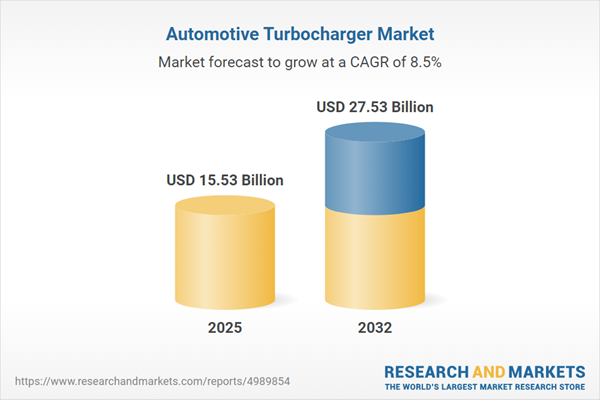Speak directly to the analyst to clarify any post sales queries you may have.
The global automotive turbocharger market is experiencing rapid evolution, shaped by advancements in engineering, regulatory pressures, and new consumer expectations. Senior leaders seeking strategic growth and operational resilience must grasp the sector’s transformation to maintain competitiveness and capitalize on emerging opportunities.
Automotive Turbocharger Market Snapshot
The Automotive Turbocharger Market expanded from USD 14.38 billion in 2024 to USD 15.53 billion in 2025. The market is forecasted to progress at a CAGR of 8.45%, reaching USD 27.53 billion by 2032. This upward trend underscores mounting industry emphasis on powertrain efficiency, regulatory compliance, and evolving mobility needs.
Scope & Segmentation
This report provides a comprehensive assessment by dissecting the global turbocharger landscape across technology, application, and region. Key categories include:
- Technology: Electric turbochargers, twin-turbo systems, parallel turbocharging, sequential turbocharging, variable geometry turbochargers, wastegate turbochargers
- Cooling System: Air-cooled turbochargers, liquid-cooled turbochargers
- Fuel Type: Diesel fuel, gas fuel (compressed natural gas, liquefied natural gas), petrol fuel
- Material: Aluminum, cast iron, steel
- Sales Channel: Offline sales, online sales
- Vehicle Type: Heavy commercial vehicles, light commercial vehicles, construction equipment, tractors, hatchbacks, sedans, SUVs
- End User: Aftermarket, original equipment manufacturers (OEMs)
- Regions: Americas (United States, Canada, Mexico, Brazil, Argentina, Chile, Colombia, Peru), Europe, Middle East & Africa (United Kingdom, Germany, France, Russia, Italy, Spain, Netherlands, Sweden, Poland, Switzerland, United Arab Emirates, Saudi Arabia, Qatar, Turkey, Israel, South Africa, Nigeria, Egypt, Kenya), Asia-Pacific (China, India, Japan, Australia, South Korea, Indonesia, Thailand, Malaysia, Singapore, Taiwan)
Key Takeaways
- Turbocharging technology has become a cornerstone in achieving vehicle downsizing without compromising performance, as OEMs face escalating emissions standards and customer preference for improved fuel economy.
- Variable geometry and twin-turbo systems are widely adopted for their ability to enhance transient response and torque at diverse engine speeds, supporting both heavy-duty and high-performance applications.
- Emerging trends highlight electric turbochargers and the integration of additive manufacturing, enabling rapid prototyping and the production of complex, lightweight designs.
- Material selection remains critical as lightweight aluminum housings help reduce overall vehicle weight, while robust steel and cast iron options ensure durability under intensive operating conditions.
- The market’s dual-channel approach, balancing demand from both OEM and aftermarket segments, increases product reach and addresses diversified end-user requirements.
- Asia-Pacific leads global growth due to its expanding automotive manufacturing base, rising middle class, and adoption of advanced turbocharging in passenger and commercial vehicles.
Tariff Impact on Supply Chains
Recent U.S. tariffs on imported turbocharger components have compelled manufacturers to reconsider logistics strategies. Many have moved toward regional sourcing and local production, fostering supply chain resilience, especially in North America. The resulting cost pressures have accelerated supplier diversification and prompted strategic partnerships with domestic foundries and machining specialists. End users are evaluating total cost of ownership, underscoring the increased relevance of product longevity and maintenance intervals.
Methodology & Data Sources
Insights are derived through a blend of primary interviews with industry executives and extensive secondary research covering technical publications, patent data, and regulatory documentation. Data points are validated via proprietary databases, and qualitative findings are refined through repeated expert consultations.
Why This Report Matters
- Enables informed decision-making on investments, supply chain strategies, and product innovation in the fast-evolving turbocharger landscape.
- Provides actionable segmentation that helps align product offerings with key technological and regional demand drivers across the market.
- Equips leadership with a clear understanding of regulatory and technological trends influencing competitive positioning.
Conclusion
Prioritizing innovation, supply chain agility, and regulatory foresight will be pivotal for industry leaders navigating the dynamic turbocharger market. This report provides a robust foundation for strategy development as electrification, efficiency imperatives, and market complexity accelerate further.
Additional Product Information:
- Purchase of this report includes 1 year online access with quarterly updates.
- This report can be updated on request. Please contact our Customer Experience team using the Ask a Question widget on our website.
Table of Contents
3. Executive Summary
4. Market Overview
7. Cumulative Impact of Artificial Intelligence 2025
Companies Mentioned
The companies profiled in this Automotive Turbocharger market report include:- ABB Ltd.
- Banks Power
- BMTS Technology GmbH & Co. KG
- BorgWarner, Inc.
- CARDONE Industries, Inc.
- Continental AG
- Cummins Inc.
- Garrett Motion Inc.
- IHI Corporation
- MAHLE GmbH
- Mitsubishi Heavy Industries Ltd.
- Ningbo Motor Industrial Co. Ltd.
- Nissens Automotive A/S
- SPA Turbo USA
- Turbo Concepts, LLC
- Turbo Dynamics Ltd.
- TURBO ENERGY PRIVATE LIMITED
- Turbonetics, Inc.
- Turbosmart Pty Ltd
- Toyota Motor Corporation
- Honeywell International Inc.
Table Information
| Report Attribute | Details |
|---|---|
| No. of Pages | 186 |
| Published | November 2025 |
| Forecast Period | 2025 - 2032 |
| Estimated Market Value ( USD | $ 15.53 Billion |
| Forecasted Market Value ( USD | $ 27.53 Billion |
| Compound Annual Growth Rate | 8.4% |
| Regions Covered | Global |
| No. of Companies Mentioned | 22 |









